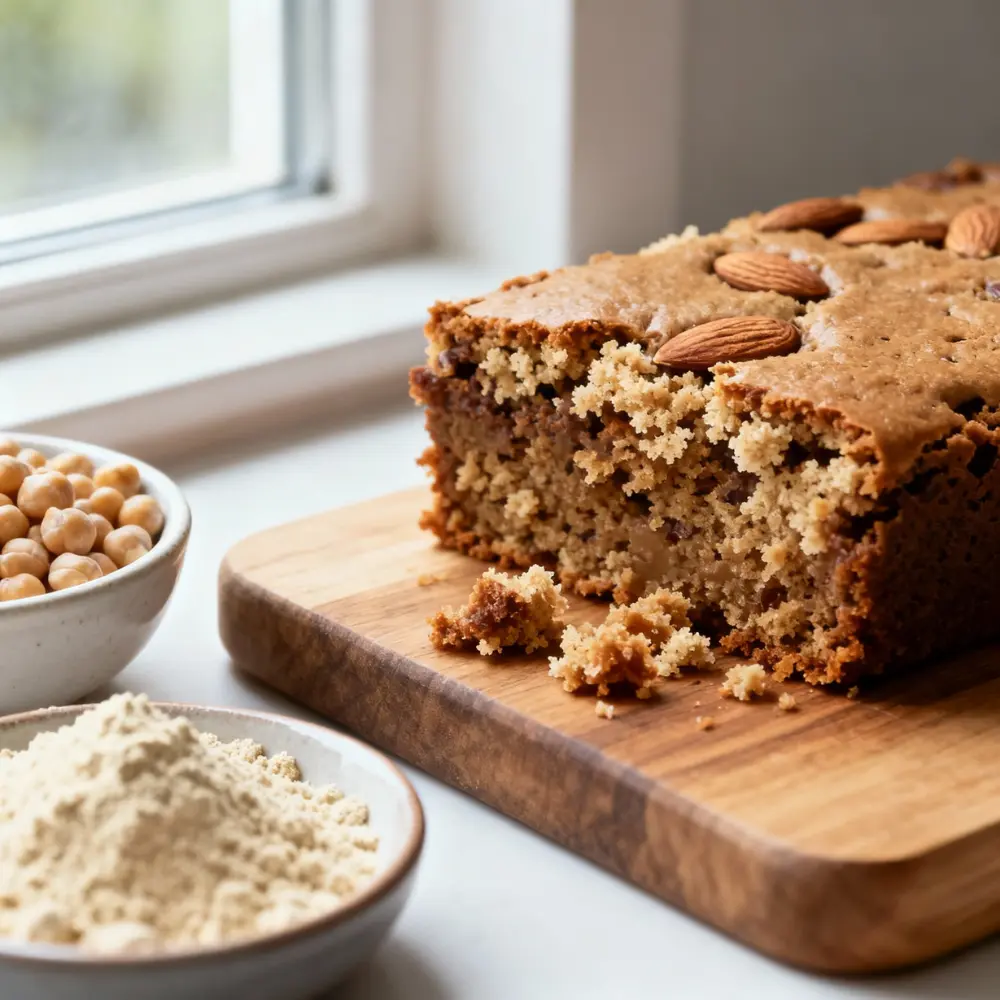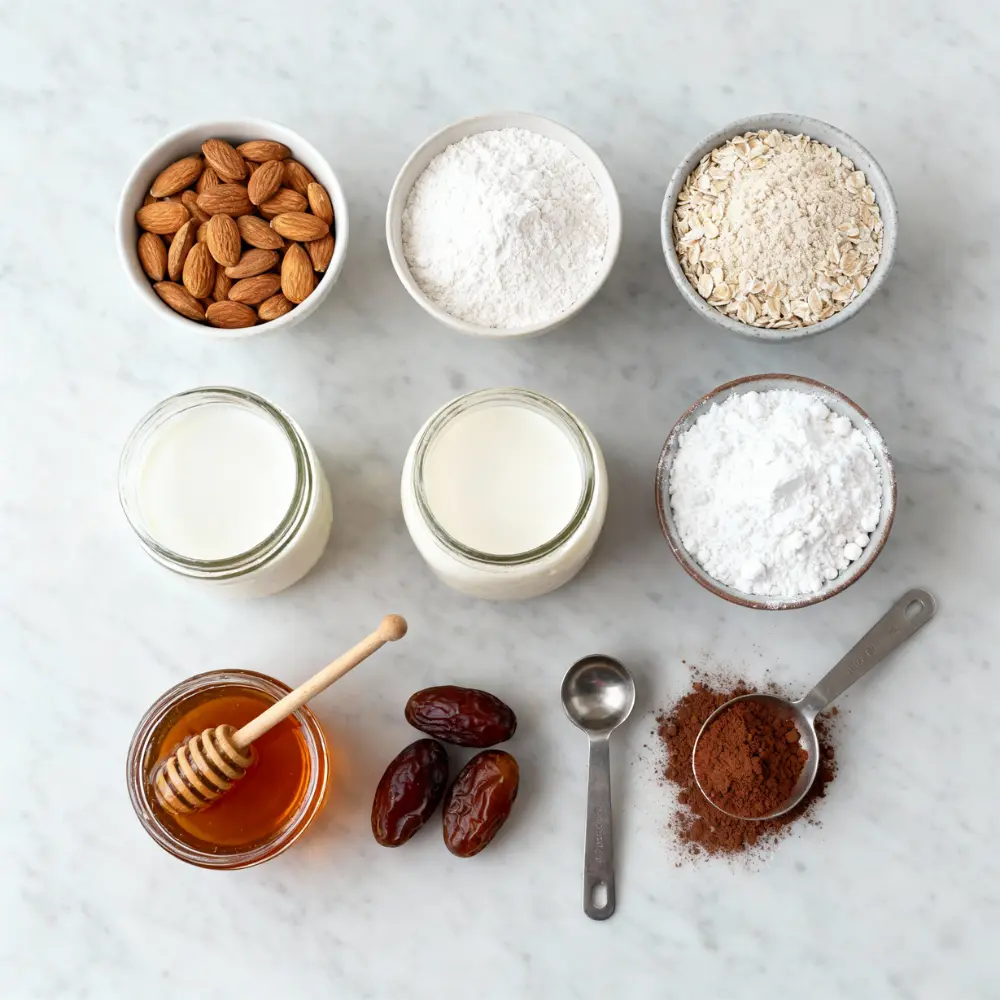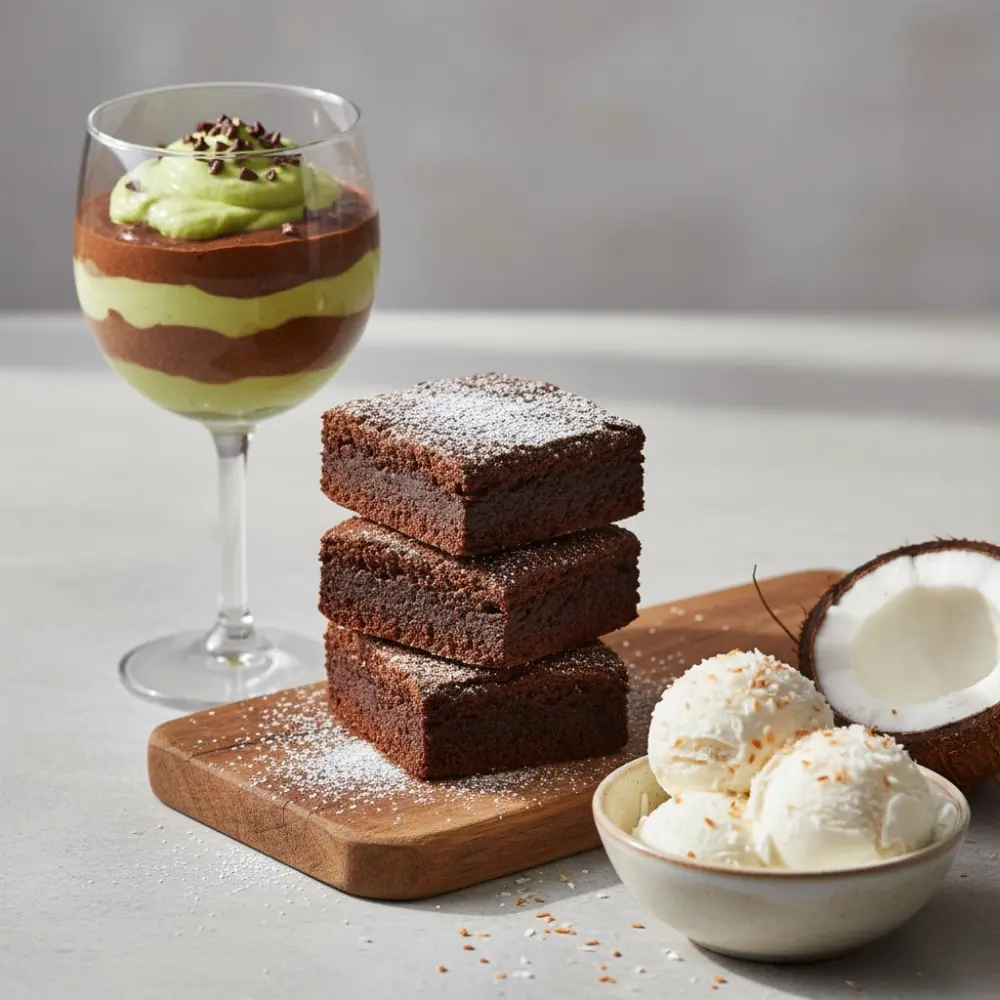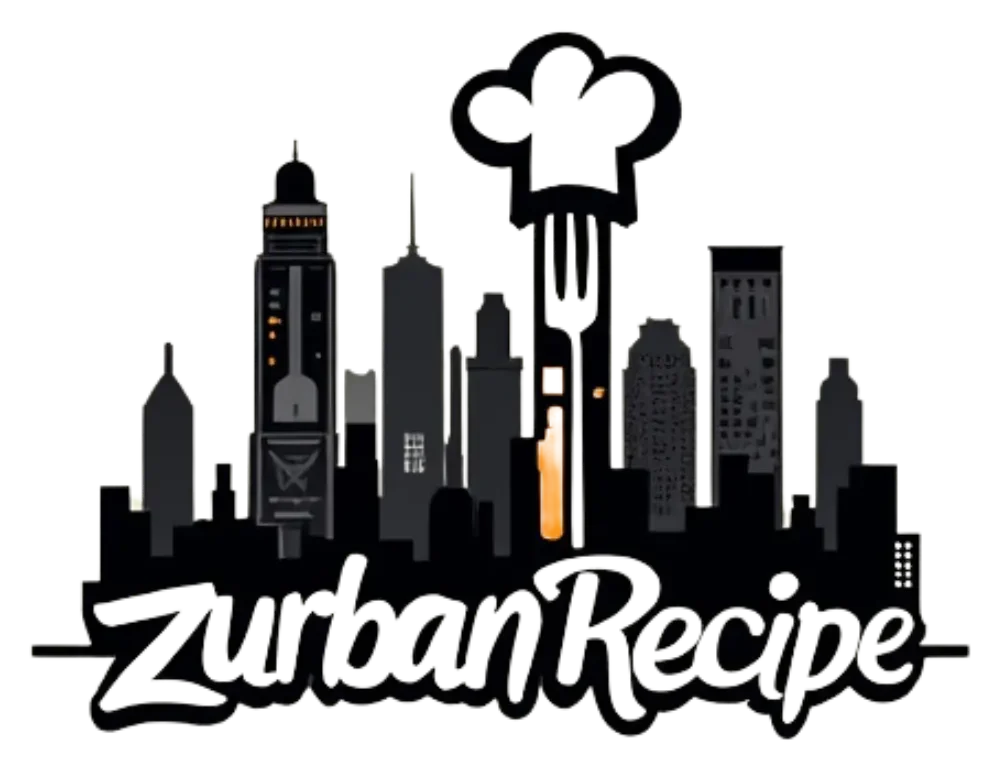Cutting out gluten and dairy doesn’t mean skipping dessert. These Gluten and Dairy Free desserts deliver indulgent flavor and clean, satisfying texture, from chocolate treats to bright fruit favorites.
Table of Contents
Gluten and Dairy Free desserts keep the joy of sweet endings without the usual ingredients. You’ll find chocolatey indulgence, cool spoonable creams, and fruit-forward bites that are easy to make, friendly for different needs, and ready for any weeknight craving.
Listen to the Podcast, Gluten and Dairy Free Desserts That Still Wow
Mia invites Chef Brooke to break down the real secrets behind gluten and dairy free treats, smart ingredient swaps, texture tricks, and flavor habits that keep every bite soft, rich, and irresistible. Hit play and hear how to turn restrictions into delicious results.
Benefits of Choosing Gluten and Dairy Free Desserts
If you’re still wondering whether Gluten and Dairy Free desserts are worth the switch, here are real perks you can feel and taste.
Health Advantages of Going Gluten Free
Gluten and Dairy Free desserts have moved from niche to mainstream as awareness of allergies and sensitivities grows. Innovation is booming, from cashew based cheesecakes to oat milk ice creams, with options that appeal to anyone who loves good food. For simple ideas on busy days, explore quick recipes that stay Gluten and Dairy Free.

Why Dairy Free is a Better Option for Some
Lactose intolerance is common, so swapping to non dairy options can turn dessert from discomfort to enjoyment. Plant based milks and creams are often lower in saturated fat and frequently fortified with calcium and vitamin D, so Gluten and Dairy Free choices fit clean eating goals.
Many adults experience some level of lactose intolerance. If dairy leaves you uncomfortable, plant milks and creams are easy swaps that keep desserts lush. For body, use soy milk; for gentle sweetness, use oat milk; for a neutral base, use almond milk. For custards and puddings, whisk 2 teaspoons cornstarch per cup of plant milk and simmer to thicken; for a sliceable set, use ½–1 teaspoon agar-agar powder per cup. Always check labels for hidden dairy derivatives.
The Growing Popularity of Allergy Friendly Desserts
Gluten and Dairy Free desserts have moved from niche to mainstream as awareness of allergies and sensitivities grows. Innovation is booming, from cashew based cheesecakes to oat milk ice creams, with options that appeal to anyone who loves good food. For simple ideas on busy days, explore quick recipes that stay Gluten and Dairy Free.
What Gluten-Free Means, in Practice
In the United States, any food labeled as gluten-free must meet a strict standard of containing less than 20 parts per million of gluten. This is the lowest level that can be reliably detected with modern testing methods and ensures safety for most people with gluten sensitivity or celiac disease.
A Quick Note on Oats
Oats are naturally gluten-free, but they can become contaminated with gluten during growing or processing. Always choose oats and oat-based products that are specifically labeled gluten-free, and adjust based on your personal tolerance.
Key Ingredients for Gluten and Dairy Free Desserts
Now that we’ve tackled the challenges, let’s spotlight the building blocks that make Gluten and Dairy Free desserts shine. From flours to sweeteners, these pantry staples help every Gluten and Dairy Free treat taste impressive and feel satisfying.

Gluten-Free Flours: Almond, Coconut, and More
Gluten free baking starts with the right flour. While there’s no one size fits all, these favorites anchor reliable Gluten and Dairy Free results:
• Almond flour: perfect for moist cakes and cookies, rich and nutrient dense. You can also read more about the health benefits of almonds behind this versatile ingredient
• Coconut flour: highly absorbent, ideal for light, fluffy bakes.
• Rice flour: versatile for pie crusts, brownies, and muffins.
• Oat flour: adds hearty texture to pancakes and quick breads.
Pro Tip: Combine flours. A mix of almond and rice flour balances moisture and structure in Gluten and Dairy Free batters.
Non-Dairy Milk Options: Almond, Soy, and Oat Milk
Plant based milks are essential for dairy free desserts. Almond milk is mild and versatile, soy milk brings creamy body, and oat milk adds natural sweetness for puddings and custards. Homemade options keep a clean label and fit a Gluten and Dairy Free kitchen.
Sweeteners and Flavor Enhancers for Allergy-Friendly Desserts
Natural sweeteners add depth without heavy processing. Maple syrup, agave nectar, and coconut sugar work well, while dates or bananas sweeten and bind. Cocoa powder, peanut butter, and unsweetened applesauce boost flavor and moisture. These same ingredients also shine in adaptable treats like these chocolate chip cookie bars, easily made gluten and dairy free with a few smart swaps.
Quick Substitutions and Ratios
| Swap | Use this | Ratio / Note |
|---|---|---|
| Milk → plant milk | Almond, soy, or oat milk | 1 cup dairy milk = 240 ml plant milk |
| Butter in cakes/brownies → oil | Coconut oil or neutral oil | 113 g butter = 90–100 g coconut oil, or 80–90 ml neutral oil |
| Heavy cream (for whipping) | Full-fat coconut cream, chilled | Use equal volume, whip cold; stabilize with 1–2 tsp cornstarch if needed |
| Buttermilk | Plant milk + acid | 1 cup plant milk + 1 tbsp lemon juice or vinegar, rest 5 min |
| Sweetener → maple syrup | Replace white sugar | Reduce other liquid by 1–2 tbsp per ¼ cup maple syrup |
| Sweetener → coconut sugar | 1:1 by weight | Expect a slightly drier crumb, weigh for accuracy |
| Egg (binding) | Flax or chia “egg” | 1 tbsp ground flax/chia + 3 tbsp water = 1 egg; rest 10–15 min |
| All-purpose GF blend (starter) | Rice + almond + tapioca | 50% rice flour, 25% almond flour, 25% tapioca starch + ¼–½ tsp xanthan per cup flour for cakes/muffins |
| Structure for breads/doughs | Psyllium husk | 1 tsp per cup flour, hydrate in warm water first |
| Moisture insurance | Batter rest | Rest batters 10–15 min to hydrate flours and activate binders |
Short notes
- Weigh ingredients when possible for consistent results.
- Adjust bake times by 3–5 minutes when swapping sweeteners or fats, and check doneness by visual cues.
Quick Start, 10-Minute Dessert
Chocolate Date Truffles

Ingredients
- 1 cup pitted Medjool dates
- 2 tbsp unsweetened cocoa powder
- 2 tbsp almond butter
- 1–2 tsp water as needed
- Pinch of salt
- Optional coatings, cocoa powder or finely shredded coconut
Directions
- Blend dates, cocoa, almond butter, salt until a sticky paste forms.
- Add water 1 tsp at a time if needed to help it come together.
- Roll into small balls and dust with cocoa or coconut.
- Chill 5 minutes. Ready to serve.
Why it works
Naturally gluten and dairy free. Dates bind and sweeten. Almond butter adds richness. Zero bake, fast clean up.
Top Recipes for Gluten and Dairy Free Desserts
Ready to roll up your sleeves and start baking? Here are some must-try recipes that prove gluten and dairy-free desserts can be just as delightful as traditional ones.

Chocolate Avocado Mousse Recipe
This creamy, decadent mousse is a chocolate lover’s dream and you’d never guess it’s made with avocado.
- Ingredients:
- 2 ripe avocados
- ½ cup unsweetened cocoa powder
- ¼ cup maple syrup
- 1 tsp vanilla extract
- Instructions:
Blend all ingredients until smooth. Chill for an hour and serve with fresh berries.
Almond Flour Brownies with Coconut Cream
These brownies are rich, fudgy, and topped with a dollop of whipped coconut cream.
- Ingredients:
- 1 cup almond flour
- ½ cup cocoa powder
- ½ cup coconut sugar
- 2 eggs (or flaxseed substitute)
- ½ cup melted coconut oil
- Instructions:
Mix dry and wet ingredients separately, then combine. Bake at 350°F for 20–25 minutes. Cool, and serve with whipped coconut cream.
Classic Vanilla Coconut Ice Cream
You don’t need an ice cream maker to whip up this dairy-free delight.
- Ingredients:
- 2 cans full-fat coconut milk
- ½ cup maple syrup
- 2 tsp vanilla extract
- Instructions:
Blend all ingredients, then freeze in a shallow container. Stir every 30 minutes for 2–3 hours until creamy.
Fruit Sorbets and Compotes
For a refreshing treat, nothing beats a homemade fruit sorbet. Simply puree your favorite fruits, sweeten with a touch of honey or agave, and freeze. For compotes, simmer fruits with a splash of water and a sprinkle of sugar until soft and syrupy.
And if you’re looking for a creative twist on fruit-based desserts, try something like this Strawberry Snowball Mochi Dessert, which offers a fun, chewy texture and natural gluten-free appeal.
Troubleshooting Gluten and Dairy Free Desserts
Crumbly cookies or bars: Add a little more binder (¼ tsp xanthan or 1 tsp flax gel), or 1–2 tsp extra water. Rest the dough 10 minutes and avoid overbaking.
Gummy or dense center in cakes: Bake until the top looks matte and springs back. Let cool completely before slicing so the structure can set.
Dry or sandy texture: Stir 1–2 tbsp extra plant milk or a spoon of applesauce into the batter to boost moisture, and reduce bake time 3–5 minutes.
Flat or heavy muffins: Check that your baking powder or soda is fresh and properly measured. Hydrate psyllium or gums before adding.
Uneven rise or cracks: Mix gently, avoid overbeating. Rest batters 10–15 minutes so air bubbles settle for smoother tops.
Going dairy free? Just make sure you’re still getting enough vitamin D. This NCBI study explains how.
Tips for Baking Perfect Gluten and Dairy Free Desserts
Creating Gluten and Dairy Free desserts can feel intimidating, but a few reliable habits make the process smooth and rewarding. Baking is art and science, and with alternative ingredients the balance matters even more for consistent Gluten and Dairy Free results.
Understanding the Role of Binders and Stabilizers
Breads, rolls, and doughs: Use psyllium husk for elasticity and chew. Hydrate it first in warm water to form a gel. Start with about 1 teaspoon per cup of flour.
Cakes, muffins, and soft cookies: Add xanthan gum to create a cohesive crumb. Typical range: ¼ to ½ teaspoon per cup of flour.
Egg-free desserts: For cookies or quick breads, mix 1 tablespoon of flaxseed or chia seeds with 3 tablespoons of water to replace one egg. Chia is not only effective as a binder, it also offers nutritional perks you can explore in the health benefits of chia seeds. Let it rest 10–15 minutes before adding.
Pro tip: Rest batters for 10–15 minutes before baking so flours hydrate and binders activate, improving texture and structure.
Balancing Moisture Levels for Best Results
Gluten free flours absorb more liquid, so adjust batters with almond milk or coconut milk until the consistency feels right. Let batters rest 10 to 15 minutes before baking so flours hydrate fully. This simple pause improves texture in Gluten and Dairy Free recipes.
Experimenting with Flavors and Textures
Mix flours, add coconut flakes, dried fruits, or warm spices like turmeric and ginger. For cookies, try chopped nuts or dairy free chocolate chips. For cakes, a thin fruit compote layer adds moisture and flavor, or try a layered dessert like this Strawberry Lasagna, which brings together fruit, creaminess, and texture in a crowd-pleasing format. Fans of nostalgic comfort foods can explore Grandma’s Recipes for classics adapted to a Gluten and Dairy Free approach.

Frequently Asked Questions (FAQs)
Are oats and oat milk safe in Gluten and Dairy Free desserts
Choose certified gluten free oats and oat milk to reduce cross contact; some people still react, so adjust based on tolerance.
How do I stop Gluten and Dairy Free cakes and cookies from crumbling
Add binders like eggs, flax or chia gel, or a pinch of xanthan; rest batter 10–15 minutes and avoid overbaking.
How do I replace milk and butter in Gluten and Dairy Free desserts
Use almond, soy, or oat milk for liquids; for fat, choose dairy free margarine, coconut oil, or neutral oils measured by weight.
What flours work best for Gluten and Dairy Free desserts
What flours work best for Gluten and Dairy Free desserts
Almond, oat, rice, and tapioca work well, but a balanced blend gives better structure, tenderness, and consistent rise. If you’re looking for more ideas and inspiration, our Healthy Baking Recipes Guide covers even more gluten-free tips and nutritious swaps.

